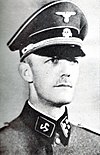
The Waffen-SS was the combat branch of the Nazi Party's paramilitary Schutzstaffel (SS) organisation. Its formations included men from Nazi Germany, along with volunteers and conscripts from both occupied and unoccupied lands.
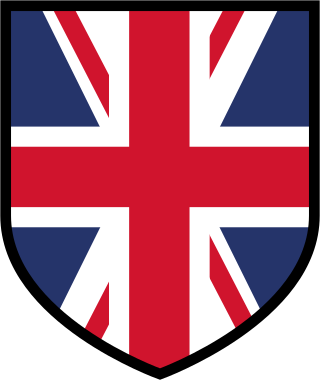
The British Free Corps was a unit of the Waffen-SS of Nazi Germany during World War II, made up of British and Dominion prisoners of war who had been recruited by Germany. The unit was originally known as the Legion of St George. Research by British historian Adrian Weale has identified 54 men who belonged to this unit at one time or another, some for only a few days. At no time did it reach more than 27 men in strength.
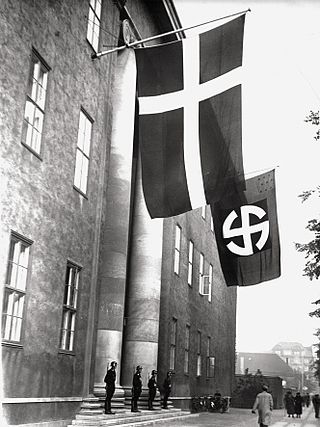
At the outset of World War II in September 1939, Denmark declared itself neutral. For most of the war, the country was a protectorate and then an occupied territory of Germany. The decision to occupy Denmark was taken in Berlin on 17 December 1939. On 9 April 1940, Germany occupied Denmark in Operation Weserübung. The Danish government and king functioned in a relatively normal manner in a de facto protectorate over the country until 29 August 1943, when Germany placed Denmark under direct military occupation, which lasted until the Allied victory on 5 May 1945. Contrary to the situation in other countries under German occupation, most Danish institutions continued to function relatively normally until 1945. Both the Danish government and king remained in the country in an uneasy relationship between a democratic and a totalitarian system until 1943 when the Danish government stepped down in protest against German demands that included instituting the death penalty for sabotage.

Felix Martin Julius Steiner was a German SS commander during the Nazi era. During World War II, he served in the Waffen-SS, the combat branch of the SS, and commanded several SS divisions and corps. He was awarded the Knight's Cross of the Iron Cross with Oak Leaves and Swords. Together with Paul Hausser, he contributed significantly to the development and transformation of the Waffen-SS into a combat force made up of volunteers and conscripts from both occupied and un-occupied lands.

Reichsführer-SS was a special title and rank that existed between the years of 1925 and 1945 for the commander of the Schutzstaffel (SS). Reichsführer-SS was a title from 1925 to 1933, and from 1934 to 1945 it was the highest rank of the SS. The longest-serving and most noteworthy office holder was Heinrich Himmler.

The 11th SS Volunteer Panzergrenadier Division Nordland was a Waffen-SS division primarily raised with Germans and ethnic Germans from Romania, but also foreign volunteers from Northern and Western Europe. It saw action, as part of Army Group North, in the Independent State of Croatia and on the Eastern Front during World War II.

The Flemish Legion was a collaborationist military formation recruited among Dutch-speaking volunteers from German-occupied Belgium, notably from Flanders, during World War II. It was formed in the aftermath of the German invasion of the Soviet Union and fought on the Eastern Front in the Waffen SS alongside similar formations from other parts of German-occupied Western Europe.

The 5th SS Panzer Division Wiking or SS Division Wiking was an infantry and later an armoured division among the thirty-eight Waffen-SS divisions of Nazi Germany. During World War II, the division served on the Eastern Front. It surrendered on 9 May 1945 to the American forces in Austria.

The Germanic SS was the collective name given to paramilitary and political organisations established in parts of German-occupied Europe between 1939 and 1945 under the auspices of the Schutzstaffel (SS). The units were modeled on the Allgemeine SS in Nazi Germany and established in Belgium, Denmark, the Netherlands, and Norway—population groups who were considered to be especially "racially suitable" by the Nazis. They typically served as local security police augmenting German units of the Gestapo, Sicherheitsdienst (SD), and other departments of the German Reich Security Main Office (RSHA), rendering them culpable for their participation in Nazi atrocities.

The Walloon Legion was a unit of the German Army (Wehrmacht) and later of the Waffen-SS recruited among French-speaking collaborationists in German-occupied Belgium during World War II. It was formed in the aftermath of the German invasion of the Soviet Union and fought on the Eastern Front alongside similar formations from other parts of German-occupied Western Europe.

The Volunteer Legion Netherlands was a collaborationist military formation recruited in the German-occupied Netherlands during World War II. It was formed in the aftermath of the German invasion of the Soviet Union and fought on the Eastern Front in the Waffen SS alongside similar formations from other parts of German-occupied Western Europe. It was the largest Dutch SS unit.

The National Socialist Workers' Party of Denmark was the largest Nazi Party in Denmark before and during the Second World War.

Søren Kam was a Danish junior officer in the Waffen-SS of Nazi Germany during World War II. He was wanted for murder in Denmark and listed by the Simon Wiesenthal Center as one of the most wanted Nazi war criminals.
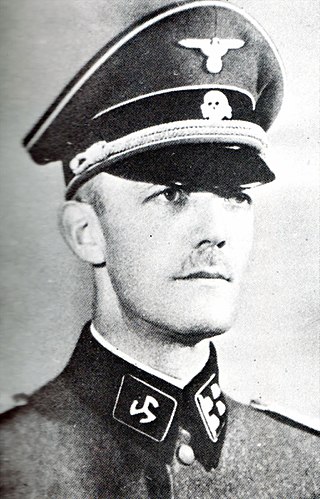
Christian Peder Kryssing, commonly known as C.P. Kryssing, was a Danish collaborator with Nazi Germany during World War II. An artillery officer and an ardent anti-communist, he commanded the Free Corps Denmark from 1941 to 1942. He was not a member of the Danish Nazi party, the National Socialist Workers' Party of Denmark.

Christian Frederik von Schalburg was a Danish army officer, the second commander of Free Corps Denmark and brother of Vera Schalburg.
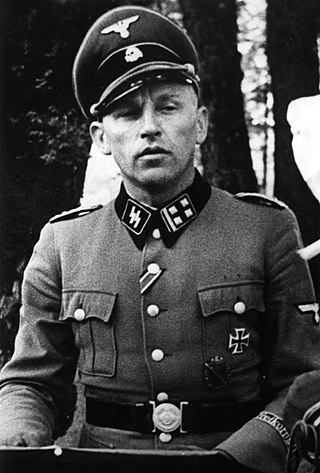
Knud Børge Martinsen was a Danish officer and the third commander of Frikorps Danmark.

During World War II, the Waffen-SS recruited significant numbers of non-Germans, both as volunteers and conscripts. In total some 500,000 non-Germans and ethnic Germans from outside Germany, mostly from German-occupied Europe, were recruited between 1940 and 1945. The units were under the control of the SS Führungshauptamt beneath Reichsführer-SS Heinrich Himmler. Upon mobilization, the units' tactical control was given to the Oberkommando der Wehrmacht.
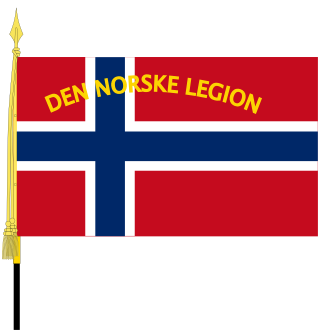
Norwegian Legion was a Norwegian collaborationist formation of the Waffen-SS during World War II. It was formed in German-occupied Norway on 29 June 1941, in support of the war aims of Nazi Germany. The unit was disbanded in 1943.
Claus Bundgård Christensen is a Danish historian and associate professor at Roskilde University known for his books related to collaboration and crime in Denmark during and following World War II.


